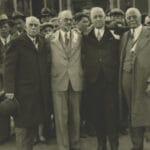Encountering individuals engaged in door-to-door ministry often brings to mind two groups: Jehovah’s Witnesses and members of The Church of Jesus Christ of Latter-day Saints (often referred to as Mormons). Both faiths are known for their active proselytizing, yet represent distinct branches within Christianity. This article offers a comprehensive comparison, exploring the core doctrinal differences and practices that distinguish these two faiths.
Divergent Paths to Salvation: Core Beliefs
Jehovah’s Witnesses and Latter-day Saints, while both identifying as Christian, follow divergent theological paths. These differences shape their understanding of God, Jesus, salvation, and the afterlife, ultimately impacting their daily lives and community structures. Dive deeper into community information with our comprehensive ivoterguide or explore the unique charm and community of Jasonville, Indiana.
One God or a Godhead?
One of the most fundamental distinctions lies in their understanding of the divine. Jehovah’s Witnesses believe in one God, whom they call Jehovah, rejecting the traditional Christian doctrine of the Trinity. They view Jesus as God’s son, a distinct and powerful being, but separate from God himself, similar to the relationship between a king and a prince. The Holy Spirit, in their view, is God’s active force, an impersonal energy rather than a distinct entity.
Latter-day Saints, conversely, believe in a Godhead composed of three distinct beings: God the Father (Elohim), Jesus Christ (Jehovah in his pre-mortal existence), and the Holy Ghost. These three are united in purpose and will, yet remain individual entities, a concept distinct from both the traditional Christian Trinity and the Jehovah’s Witnesses’ understanding of a singular God.
The Path to Eternal Life: Salvation
The two faiths also diverge on the path to salvation. Jehovah’s Witnesses believe salvation is earned through a combination of faith in Jesus’ ransom sacrifice, obedience to God’s commandments as revealed in the Bible, and active witnessing, sharing their faith with others. They believe a limited number (144,000) will go to heaven to rule with Christ, while the remaining faithful will live forever in a paradise on Earth.
Latter-day Saints believe salvation comes through faith in Jesus Christ, repentance, baptism by immersion, receiving the Gift of the Holy Ghost, and enduring to the end, striving to live according to God’s teachings throughout life. They believe in degrees of glory in the celestial kingdom (heaven), with varying levels of blessings based on an individual’s righteousness and participation in temple ordinances, sacred ceremonies performed in their temples.
Holy Writ: Scriptural Authority
Jehovah’s Witnesses primarily use the New World Translation of the Holy Scriptures, their own translation of the Bible. They believe this version restores God’s name, Jehovah, and offers a more accurate rendering than other translations.
Latter-day Saints accept the Bible (typically the King James Version) alongside additional scriptures, including the Book of Mormon, Doctrine and Covenants, and Pearl of Great Price. They view these additional texts as further revelations from God, providing added insight and guidance.
Contrasting Structures: Organization and Practices
Worship and Leadership
Jehovah’s Witnesses gather in Kingdom Halls, where the focus is on Bible study and preparation for their preaching work. They abstain from celebrating traditional Christian holidays like Christmas and Easter, believing these have pagan origins. Their leadership structure is hierarchical, governed by a Governing Body located in New York. All members are considered ministers, with no distinction between clergy and laity.
Latter-day Saints worship in meetinghouses and temples. Meetinghouses host weekly sacrament meetings (similar to communion), Sunday School classes, and other activities. Temples are reserved for sacred ordinances, including baptisms for the dead and eternal marriage ceremonies. Latter-day Saints are led by a prophet and twelve apostles, believed to hold divine authority, supported by a lay clergy serving in various leadership positions.
Sharing the Faith: Evangelism
Both groups emphasize active proselytizing. Jehovah’s Witnesses are widely recognized for their door-to-door ministry and distribution of literature. Latter-day Saints conduct missionary work globally, often sending young adults on missions to share their beliefs and provide service.
A Comparative Overview: Charting the Differences
The following table summarizes the key distinctions between the two faiths:
| Feature | Jehovah’s Witnesses | Latter-day Saints (Mormons) |
|---|---|---|
| Founder | Charles Taze Russell | Joseph Smith |
| Scriptures | New World Translation of the Holy Scriptures | Bible, Book of Mormon, Doctrine and Covenants, Pearl of Great Price |
| God | One God, Jehovah | Godhead: Father (Elohim), Son (Jesus Christ/Jehovah), Holy Spirit |
| Jesus Christ | God’s son, Michael the Archangel | Son of God, pre-mortal Jehovah, Savior |
| Holy Spirit | God’s active force | Member of the Godhead |
| Salvation | Faith, obedience, witnessing; two-tiered afterlife | Faith, repentance, baptism, ordinances; degrees of glory |
| Afterlife | Paradise Earth, heavenly reign for 144,000 | Tiered heaven, spirit prison |
| Worship | Kingdom Halls, focus on study and preaching | Meetinghouses and temples, sacrament, Sunday School |
| Leadership | Governing Body | Prophet and apostles, lay clergy |
| Evangelism | Door-to-door preaching, literature distribution | Missionary work, proselytizing |
Beyond the Basics: Exploring Further
While this article outlines the primary differences, it’s important to acknowledge the complexity and nuance within each faith. Ongoing research and theological discussions continue to shape our understanding of these beliefs. Further exploration into the social implications, historical evolution, and personal experiences within each faith can provide a richer, more comprehensive perspective. For those interested in delving deeper, numerous resources are available online and in libraries. Engaging in respectful dialogue with members of both faiths can also offer valuable insights.
- Unlocking 2-Letter Words with U: The Definitive Guide - April 4, 2025
- Unlock Words with the Letters THREE: Top Unscramble Tools 2025 - April 4, 2025
- Master Scrabble: X & Z Words for High Scores - April 4, 2025
















